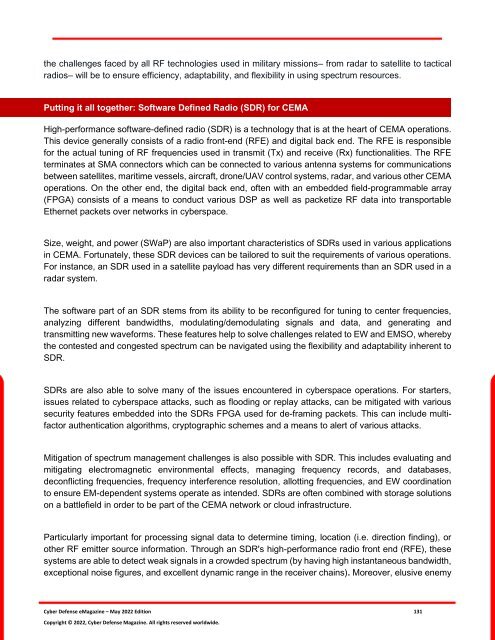Cyber Defense eMagazine May Edition for 2022
Cyber Defense eMagazine May Edition for 2022 #CDM #CYBERDEFENSEMAG @CyberDefenseMag by @Miliefsky a world-renowned cyber security expert and the Publisher of Cyber Defense Magazine as part of the Cyber Defense Media Group as well as Yan Ross, Editor-in-Chief and many more writers, partners and supporters who make this an awesome publication! Thank you all and to our readers! OSINT ROCKS! #CDM #CDMG #OSINT #CYBERSECURITY #INFOSEC #BEST #PRACTICES #TIPS #TECHNIQUES
Cyber Defense eMagazine May Edition for 2022 #CDM #CYBERDEFENSEMAG @CyberDefenseMag by @Miliefsky a world-renowned cyber security expert and the Publisher of Cyber Defense Magazine as part of the Cyber Defense Media Group as well as Yan Ross, Editor-in-Chief and many more writers, partners and supporters who make this an awesome publication! Thank you all and to our readers! OSINT ROCKS! #CDM #CDMG #OSINT #CYBERSECURITY #INFOSEC #BEST #PRACTICES #TIPS #TECHNIQUES
- No tags were found...
Create successful ePaper yourself
Turn your PDF publications into a flip-book with our unique Google optimized e-Paper software.
the challenges faced by all RF technologies used in military missions– from radar to satellite to tactical<br />
radios– will be to ensure efficiency, adaptability, and flexibility in using spectrum resources.<br />
Putting it all together: Software Defined Radio (SDR) <strong>for</strong> CEMA<br />
High-per<strong>for</strong>mance software-defined radio (SDR) is a technology that is at the heart of CEMA operations.<br />
This device generally consists of a radio front-end (RFE) and digital back end. The RFE is responsible<br />
<strong>for</strong> the actual tuning of RF frequencies used in transmit (Tx) and receive (Rx) functionalities. The RFE<br />
terminates at SMA connectors which can be connected to various antenna systems <strong>for</strong> communications<br />
between satellites, maritime vessels, aircraft, drone/UAV control systems, radar, and various other CEMA<br />
operations. On the other end, the digital back end, often with an embedded field-programmable array<br />
(FPGA) consists of a means to conduct various DSP as well as packetize RF data into transportable<br />
Ethernet packets over networks in cyberspace.<br />
Size, weight, and power (SWaP) are also important characteristics of SDRs used in various applications<br />
in CEMA. Fortunately, these SDR devices can be tailored to suit the requirements of various operations.<br />
For instance, an SDR used in a satellite payload has very different requirements than an SDR used in a<br />
radar system.<br />
The software part of an SDR stems from its ability to be reconfigured <strong>for</strong> tuning to center frequencies,<br />
analyzing different bandwidths, modulating/demodulating signals and data, and generating and<br />
transmitting new wave<strong>for</strong>ms. These features help to solve challenges related to EW and EMSO, whereby<br />
the contested and congested spectrum can be navigated using the flexibility and adaptability inherent to<br />
SDR.<br />
SDRs are also able to solve many of the issues encountered in cyberspace operations. For starters,<br />
issues related to cyberspace attacks, such as flooding or replay attacks, can be mitigated with various<br />
security features embedded into the SDRs FPGA used <strong>for</strong> de-framing packets. This can include multifactor<br />
authentication algorithms, cryptographic schemes and a means to alert of various attacks.<br />
Mitigation of spectrum management challenges is also possible with SDR. This includes evaluating and<br />
mitigating electromagnetic environmental effects, managing frequency records, and databases,<br />
deconflicting frequencies, frequency interference resolution, allotting frequencies, and EW coordination<br />
to ensure EM-dependent systems operate as intended. SDRs are often combined with storage solutions<br />
on a battlefield in order to be part of the CEMA network or cloud infrastructure.<br />
Particularly important <strong>for</strong> processing signal data to determine timing, location (i.e. direction finding), or<br />
other RF emitter source in<strong>for</strong>mation. Through an SDR's high-per<strong>for</strong>mance radio front end (RFE), these<br />
systems are able to detect weak signals in a crowded spectrum (by having high instantaneous bandwidth,<br />
exceptional noise figures, and excellent dynamic range in the receiver chains). Moreover, elusive enemy<br />
<strong>Cyber</strong> <strong>Defense</strong> <strong>eMagazine</strong> – <strong>May</strong> <strong>2022</strong> <strong>Edition</strong> 131<br />
Copyright © <strong>2022</strong>, <strong>Cyber</strong> <strong>Defense</strong> Magazine. All rights reserved worldwide.


















